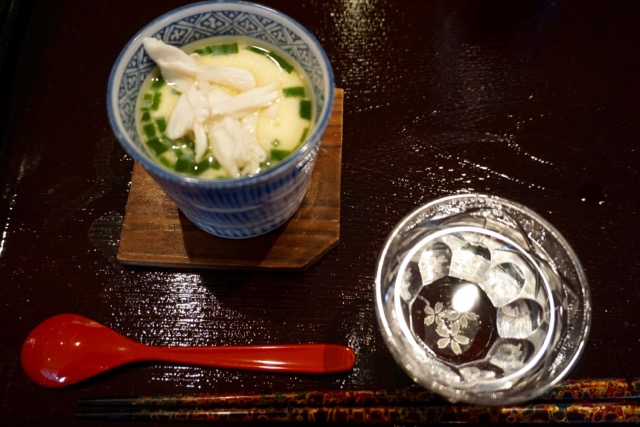We really like crab cakes and make them every-now-and-then. We bought an 8oz container of pasteurized lump crab meat some time ago and decided to make a crab cake (other choices would include a California roll or cream crab croquet). I usually make crab cakes without using much in the way of binders (just mayo, Dijon mustard and a small amount of bread crumbs). My philosophy is the less binders/fillers the better to let the taste of the crab shine through. But sometimes this technique makes it difficult for the crab cakes to keep their shape while cooking (especially flipping). I remembered seeing a recipe using shrimp meat (mousse) as a binder. I looked for the recipe and came across a video from America’s test kitchen demonstrating how to use shrimp as a binder for crab cake. As usual, I made some modifications but we really like this version of crab cake. You do not taste the shrimp and the crab cakes stay together without adding any unwanted texture or flavors. Of course, using a good lump crab meat is important to making a good crab cake. I served it with coleslaw I had just made and blanched rapini.
The original recipe calls for breading but I did not do that. I did, however, add a small amount of bread crumbs (panko) to the crab mixture.
Ingredients (makes 4 small cakes):
8oz (270gram) lump crab (#1)
2oz (57gram) shrimp (about 1/4 the weight of the crab), thawed and cut up into small pieces
2-3 tbs cream
1 tbs Dijon mustard
2 tbs Panko bread crumbs
1-2 tbs olive oil
1 stalk of celery, finely diced
1 small shallot, finely diced
1 small Jalapeño pepper, seeded and deveined, finely diced (optional)
1 tbs olive oil for sautéing the above
Salt and pepper to taste
Directions:
Sauté the celery, shallot, and Jalapeño pepper in olive oil for several minutes, season with salt and pepper and set it aside to cool (#2, on the bottom of the bowl)
Add the shrimp in a small food processor (I used a cylindrical container with an immersion blender), add the cream and process to make a smooth mousse and add to the vegetables and crab meat (#3)
Add the Dijon mustard and Panko bread crumbs and gently fold to mix (#4)
Form 6 small disks (#5) and refrigerate at least 30 minutes
Cook crab cakes with olive oil on medium flame for 2 minutes for each side (#6)
This is a great recipe for making crab cakes. The shrimp moose does a good job of keeping the cakes together without adding unwanted texture or flavors. It does a better job than just mayo. We will adopt this recipe as our standard recipe for crab cakes.
Showing posts with label crab. Show all posts
Showing posts with label crab. Show all posts
Saturday, May 13, 2023
Tuesday, May 14, 2019
Crab cake sushi クラブケーキちらし寿司
I made crab cakes, using a recipe I posted some time ago . From one container of crab meat, I made 5 cakes. We ate two immediately but three were left (see below). This time, I made the crab cake with sautéed onion, shiitake mushroom, jalapeño pepper and fresh dill. I also added Meyer lemon zest (micro-grated), lemon juice and seasoned it with a splash of Worcestershire sauce, salt and pepper and bound it with panko, dijon mustard and mayonnaise.
Since we had gotten the crab meat to make California roll, my wife suggested we could (sort-of) stick to our original objective by using the crab cakes to make scattered sushi ちらし寿司. Also, we had discovered, on our last trip to Japan, that ingredients such as tuna salad made with mayonnaise work really well with sushi rice. So since the crab cakes included mayo, my wife thought they should work well over the sushi rice. She made fresh rice for the occasion and I made it into sushi rice. First, I warmed the crab cakes in the toaster oven and the broke them into small chunks on the sushi rice.
Taking the cue from California rolls, I also added cubes of avocado, dressed in lemon juice and a bit of mayonnaise.
Since perilla has started coming out in profusion in our herb garden, I added a chiffonade of perilla 青じそ.
Finally, I topped it with thin strips of nori.
We had this on our day off as an ending "shime" dish. As my wife predicted this was really good. We thought that since it was a shime, the amount of rice may be too much but it tasted so good we couldn't stop and ended up eating the whole thing. As opposed to just using crab meat as is done with classic California roll, using crab cake added more complex flavor dimensions and texture. For this, we switched to our "Tengumai daiginjo" sake 天狗舞大吟醸酒.
Since we had gotten the crab meat to make California roll, my wife suggested we could (sort-of) stick to our original objective by using the crab cakes to make scattered sushi ちらし寿司. Also, we had discovered, on our last trip to Japan, that ingredients such as tuna salad made with mayonnaise work really well with sushi rice. So since the crab cakes included mayo, my wife thought they should work well over the sushi rice. She made fresh rice for the occasion and I made it into sushi rice. First, I warmed the crab cakes in the toaster oven and the broke them into small chunks on the sushi rice.
Taking the cue from California rolls, I also added cubes of avocado, dressed in lemon juice and a bit of mayonnaise.
Since perilla has started coming out in profusion in our herb garden, I added a chiffonade of perilla 青じそ.
Finally, I topped it with thin strips of nori.
We had this on our day off as an ending "shime" dish. As my wife predicted this was really good. We thought that since it was a shime, the amount of rice may be too much but it tasted so good we couldn't stop and ended up eating the whole thing. As opposed to just using crab meat as is done with classic California roll, using crab cake added more complex flavor dimensions and texture. For this, we switched to our "Tengumai daiginjo" sake 天狗舞大吟醸酒.
Monday, August 1, 2016
Lobster Bisque with carb meat カニ肉入りロブスタービスク
When I went to our regular grocery store, they had a special on previously frozen (and just starting to thaw) lobster tails at the fish counter. I got two and made sous vide butter poached lobster tails. As usual, I made lobster bisque from the shell. Compared to whole lobsters, the amount of shells and resulting bisque was just enough for 2 small servings. I served this with a mound of lump crab meat as a part of weekend lunch which was proceeded by avocado tofu.
Since I had tobiko roe, I used it as a garnish and also small cubes of cucumber (American mini-cucumber).
We had this with my baguette. As my wife says, she likes the lobster bisque almost more than eating lobster itself because it is the distilled essence of lobster without the work of cracking the shell. The addition of crab meat and tobiko roe made this bisque a little bit special.
Saturday, April 9, 2016
Hanami 2016 Day 2 花見 2016 二日目
The cherry blossoms will be over very soon but we squeezed in one more day of hanami.
Before steaming the chawanmushi I added the smaller chunks of crabmeat to the egg mixture to be cooked into the custard. After 10 minutes of steaming, when the surface of the custard was cooked enough that the crabmeat would not sink into the custard I added the largest chunks of crabmeat.
While at the market I also got a salmon filet. As usual, I removed the belly portion and made it into a drinking snack. This time I simply seasoned with salt and pepper and pan fried it in butter. I made sure the skin was nicely crispy. I served it with asparagus which were cooked in the same pan.
Still cold but nicely sunny with blue sky.
As I mentioned, previously we have three cherry trees. The newer tree, which we planted, is quite spectacular in its own right. When in full bloom the branches look like thick bottle brushes of pink cherry blossoms as shown in the picture above. The cherry blossoms on the older trees are more old-fashioned, light pink, delicately ethereal and very elegant as shown in the picture below. The two types of tree usually bloom at slightly different times. This year it was a treat that they bloomed together.
At least, for this hanami I had a chance to go to our regular grocery store and bought a few items to make more hanami drinking snacks. I realized the garlic chives ニラ have emerged in our herb garden. So I made this dish. I did not follow any recipe but it is chicken tenderloin encased in omelet with garlic chives. I served this with green beans sautéed in butter (in the same frying pan I cooked the chicken). On the side, I put ketchup and Sriracha (small amount).
I removed the small tendon/sinew from the top of the tenderloins, seasoned with salt and pepper. I chopped garlic chive I harvested from the herb garden.
I mixed in with a beaten egg.
I dipped the tenderloins in the egg mixture and started frying in butter. I added more egg mixture and I turned the tenderloins over so that the omelet encased the tenderloin. I repeated this process until all the egg mixture was used.
I also made my usual chawanmushi 茶碗蒸しwith crabmeat and garlic chives. I also put in some ginko nuts 銀杏 (from a can), chicken tenderloin thinly sliced against the grain of the meat. We used our cherry blossom cut glass sake cups.
Before steaming the chawanmushi I added the smaller chunks of crabmeat to the egg mixture to be cooked into the custard. After 10 minutes of steaming, when the surface of the custard was cooked enough that the crabmeat would not sink into the custard I added the largest chunks of crabmeat.
While at the market I also got a salmon filet. As usual, I removed the belly portion and made it into a drinking snack. This time I simply seasoned with salt and pepper and pan fried it in butter. I made sure the skin was nicely crispy. I served it with asparagus which were cooked in the same pan.
So we managed to squeeze in one more day of hanami.
Monday, February 1, 2016
Chawan-mushi flavored with lobster bisque ロブスター味の茶碗蒸し
Whenever we have lobster, I make lobster bisque from the shells and carcasses. This time I used the lobster bisque to flavor chawan-mushi 茶碗蒸し and added crab meat to make a sort of hybrid dish. I garnished it with julienne of radish and snow peas.
I put crab meat in the bottom and also on the top (I placed the top garnish including crab meat after the egg had set).
Ingredients: (6 small containers as seen below)
3 large eggs (about 150ml)
450ml Lobster bisque (or three times volume of the eggs)
Crab meat (more the better)
Snow peas and small red radish for garnish.
I beat the eggs, added the lobster bisque and mixed well. I placed crab meat in the bottom of each container and poured the egg mixture through a fine strainer into the containers. I placed the containers in a wok and steamed for 15 minutes. I checked and turned down the heat so the steam was steady but not so strong the egg mixture would developed bubbles. Once the custard set, I placed the garnishes on top including additional crab meat and steamed for another 5-10 minutes (see below).
This was good. I thought the lobster flavor would overwhelm the delicateness of the dish but it did not. It did not look any different from my usual chawan-mushi but on tasting it, the lobster bisque flavor came to the front in a nice subtle way. The sweet crab meet was also nice. This variation of chwan-mushi will make our regular (or "teibann" 定番) dish.
Thursday, December 24, 2015
Crab “Kanitama” Omelet 洋風かに玉
When we had crab meat stuffed baked lobsters recently, we had excess crab meat and I decided to make a quick crab omelet or "kanitama" かに玉. Kanitama is usually made in a round disk-shape and served with a Chinese-style sweet and sour thick sauce or "ankake" 餡かけ. I decided to make it in a rectangular shape like "Dashimaki" Japanese omelet and did not make any sauce but I did put some soy sauce on top.
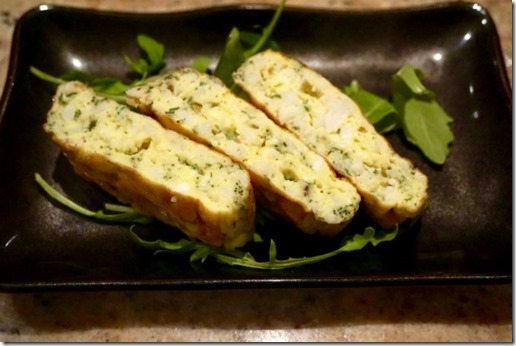
I seasoned the omelet with fresh dill, salt and pepper.
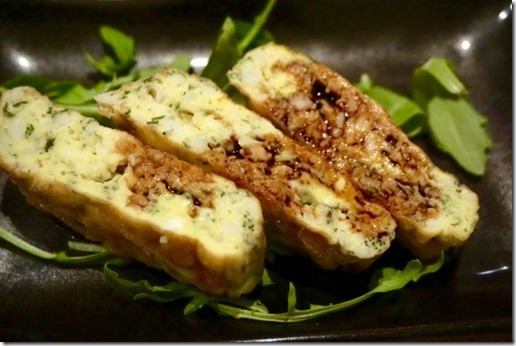
I mixed two eggs with finely copped fresh dill, crab meat and seasoned it with salt and pepper. Using my rectangular omelet pan on medium-low flame and a small mount of olive oil added, I poured in the entire egg mixture at once (left below) and started stirring so that it cooked quickly making small curds. While there was still enough uncooked egg mixture to make the folds stick together, I quickly folded the large square into a smaller square (mostly using flicking wrist motion) (right below).
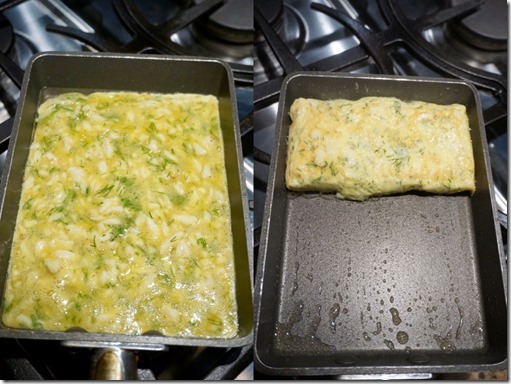
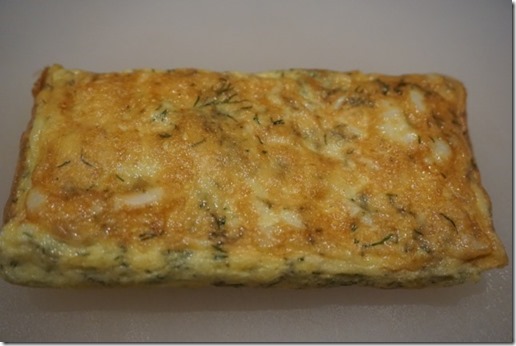
In any case, the amount of leftover crab meat was quite generous and this Japanese-Western hybrid omelet was luxurious and good.

I seasoned the omelet with fresh dill, salt and pepper.

I mixed two eggs with finely copped fresh dill, crab meat and seasoned it with salt and pepper. Using my rectangular omelet pan on medium-low flame and a small mount of olive oil added, I poured in the entire egg mixture at once (left below) and started stirring so that it cooked quickly making small curds. While there was still enough uncooked egg mixture to make the folds stick together, I quickly folded the large square into a smaller square (mostly using flicking wrist motion) (right below).

Since I was not using pasteurized eggs, I tried to make sure it was cooked through, but I may have over done it (below).

In any case, the amount of leftover crab meat was quite generous and this Japanese-Western hybrid omelet was luxurious and good.
Monday, December 21, 2015
Creamy Crab Croquettes カニクリームコロッケ
I have meant to make and post this dish for some time and I'm finally doing it. These crab cream croquettes are fairly common in Japan and can be bought pre-made and frozen, just deep fry to finish at home. A similar dish is presented in the Mark Robison's Izakaya cook book (p57). I made this as I remembered it and did not follow any particular recipe. I asked my wife if I should serve it with a sauce (Tartar sauce would be the standard but it may be served with tonkatsu or chu-no sauce とんかつソース、中濃ソース), she said just wedges of lemon to preserve the delicate flavor of the crab, which was fine with me. I also garnished it with fried crisped-up parsley.
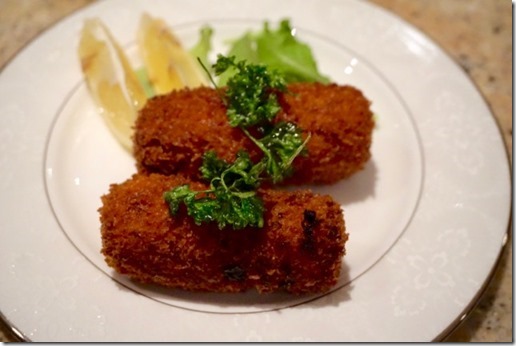
I served 2 per person as an appetizer with baby arugula.
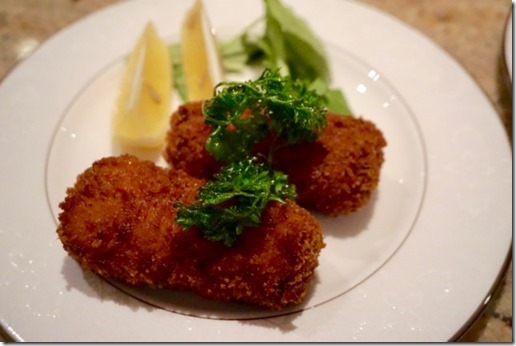
As you can see below the nice crunchy crust, conceals the hot creamy center stuffed with a plenty of crab meat.

One reason I was a bit hesitant to make this dish is that it takes some preparation and it can "explode" during the frying process which is sort of a disaster to say the least. Besides Mark Robison's Izakaya cookbook, variations of this recipe in English is available elsewhere.
Ingredients (makes 8 small croquettes seen above):
Crab meat: I used fresh lump crab meat which was leftover from making monk fish medallions with lobster/crab sauce. The amount is arbitrary, the more crab meat the better. I was told that a traditional Japanese dish, uses "canned" crab but I used fresh crab meat which was fine or even better.
Onion: One medium, finely chopped.
Butter: Unsalted, about 1 oz (30g) or a bit less (see direction below).
Flour: All purpose, about 1 oz (30g)
Milk: One and 1/3 cups (or cream if you are so inclined)
Salt and white pepper, freshly ground
Lemon zest, micro grated (optional)
Panko bread crumbs, egg, flour for breading.
Peanut oil or vegetable oil for deep frying.
Directions:
First, I made a rather stiff Béchamel sauce. As usual, I did not measure things but the above are approximate amounts. To reduce the amount of butter, I melted the butter, sautéed the onion and then added the flour. Because the flour coated the each small piece of onion, I could reduce the amount of butter/oil to make my Béchamel. When all the dry flour was gone (several minutes, I made sure not to color the flour), I added the cold milk all at once. I whisked it to dissolve/disperse the flour and kept whisking until thickened. I switched to a silicon spatula and kept mixing until the mixture had the consistency of firm mustard but not quite as firm as polenta. I mixed in the crab meat and seasoned it with salt and white pepper. On the fly, I decided to add some micro-grated lemon zest but this is optional (other things can be added such as chopped boiled eggs or creamed corn etc). I then dumped the mixture onto an aluminum foil-lined, oiled (I used light olive oil) cookie sheet and spread it out to fill the cookie sheet. I covered it with another sheet of aluminum foil and refrigerated it for an hour or until the mixture became firm (#1 below). After, the mixture stiffened, I divided the mixture into 8 portions using a slicon spatula (#2). Since it was still a bit soft, I refrigerated it for several more hours.
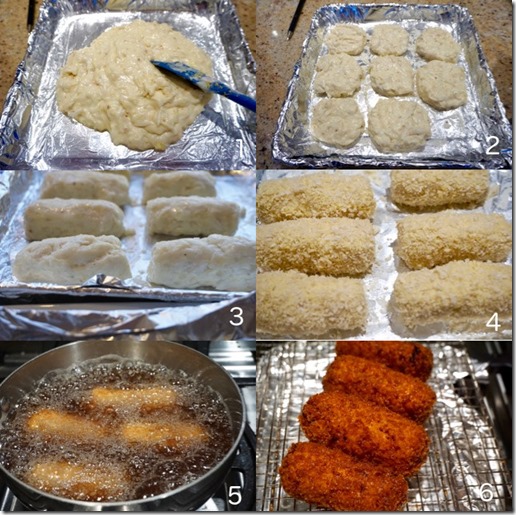
After coating my hands with olive oil, I formed each portion into small cylinders (or "tawara" shape 俵, #3). I could have made oval patties but this shape was what my mother used to make and I am following her lead. I then breaded the cylinders as per usual with, flour, egg water and panko bread crumbs (#4). At this point I had the choice of deep frying it immediately or freezing it either a short period (for 30 minutes) or completely (freezing helps prevent the dreaded exploding croquette). Since I was running out of time and we had other items to eat that evening, I decided to freeze it,
The next evening, I removed the croquettes from the freezer and deep fried, without defrosting, for an evening appetizer (#5). I used a smaller sauce pan instead of my usual frying pan so that the depth of the oil was enough to submerge the croquettes (another precaution to prevent an explosion). At 350F turning several times, I fried it for 5-7 minutes (#6).
To summarize: The steps I take to avoid a croquette explosion are: 1. make the Béchamel somewhat stiffer than usual, 2. refrigerate or, even better, freeze the croquettes before frying, 3. Fry the croquettes at a temperature of 350F or a bit higher and use enough oil so that a crust will immediately form all around.
This was a bit of work but, at the end, it was worth it. We wrapped up the remaining 4 frozen coquettes, I first wrapped them in a plastic wrap, then aluminum foil and placed them in a Ziploc bag and placed back to the freezer for a future feast. This was definitely a very decadent and excellent dish to start the evening. The crunchy crust with the unctuous soft hot interior tasting of sweet crab is irresistible.

I served 2 per person as an appetizer with baby arugula.

As you can see below the nice crunchy crust, conceals the hot creamy center stuffed with a plenty of crab meat.

One reason I was a bit hesitant to make this dish is that it takes some preparation and it can "explode" during the frying process which is sort of a disaster to say the least. Besides Mark Robison's Izakaya cookbook, variations of this recipe in English is available elsewhere.
Ingredients (makes 8 small croquettes seen above):
Crab meat: I used fresh lump crab meat which was leftover from making monk fish medallions with lobster/crab sauce. The amount is arbitrary, the more crab meat the better. I was told that a traditional Japanese dish, uses "canned" crab but I used fresh crab meat which was fine or even better.
Onion: One medium, finely chopped.
Butter: Unsalted, about 1 oz (30g) or a bit less (see direction below).
Flour: All purpose, about 1 oz (30g)
Milk: One and 1/3 cups (or cream if you are so inclined)
Salt and white pepper, freshly ground
Lemon zest, micro grated (optional)
Panko bread crumbs, egg, flour for breading.
Peanut oil or vegetable oil for deep frying.
Directions:
First, I made a rather stiff Béchamel sauce. As usual, I did not measure things but the above are approximate amounts. To reduce the amount of butter, I melted the butter, sautéed the onion and then added the flour. Because the flour coated the each small piece of onion, I could reduce the amount of butter/oil to make my Béchamel. When all the dry flour was gone (several minutes, I made sure not to color the flour), I added the cold milk all at once. I whisked it to dissolve/disperse the flour and kept whisking until thickened. I switched to a silicon spatula and kept mixing until the mixture had the consistency of firm mustard but not quite as firm as polenta. I mixed in the crab meat and seasoned it with salt and white pepper. On the fly, I decided to add some micro-grated lemon zest but this is optional (other things can be added such as chopped boiled eggs or creamed corn etc). I then dumped the mixture onto an aluminum foil-lined, oiled (I used light olive oil) cookie sheet and spread it out to fill the cookie sheet. I covered it with another sheet of aluminum foil and refrigerated it for an hour or until the mixture became firm (#1 below). After, the mixture stiffened, I divided the mixture into 8 portions using a slicon spatula (#2). Since it was still a bit soft, I refrigerated it for several more hours.

After coating my hands with olive oil, I formed each portion into small cylinders (or "tawara" shape 俵, #3). I could have made oval patties but this shape was what my mother used to make and I am following her lead. I then breaded the cylinders as per usual with, flour, egg water and panko bread crumbs (#4). At this point I had the choice of deep frying it immediately or freezing it either a short period (for 30 minutes) or completely (freezing helps prevent the dreaded exploding croquette). Since I was running out of time and we had other items to eat that evening, I decided to freeze it,
The next evening, I removed the croquettes from the freezer and deep fried, without defrosting, for an evening appetizer (#5). I used a smaller sauce pan instead of my usual frying pan so that the depth of the oil was enough to submerge the croquettes (another precaution to prevent an explosion). At 350F turning several times, I fried it for 5-7 minutes (#6).
To summarize: The steps I take to avoid a croquette explosion are: 1. make the Béchamel somewhat stiffer than usual, 2. refrigerate or, even better, freeze the croquettes before frying, 3. Fry the croquettes at a temperature of 350F or a bit higher and use enough oil so that a crust will immediately form all around.
This was a bit of work but, at the end, it was worth it. We wrapped up the remaining 4 frozen coquettes, I first wrapped them in a plastic wrap, then aluminum foil and placed them in a Ziploc bag and placed back to the freezer for a future feast. This was definitely a very decadent and excellent dish to start the evening. The crunchy crust with the unctuous soft hot interior tasting of sweet crab is irresistible.
Subscribe to:
Posts (Atom)


















